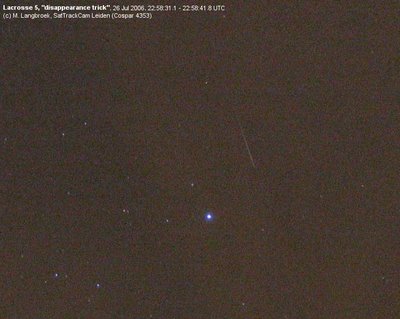
(click image for enlargement)
Movement is from bottom to top here. Lyra is well recognizable. You can see the trail quickly fading out (it takes maybe 2-3 seconds in total). In fact, the trail should end between 13 & 16 Lyr (the two stars above the trail) on this 10.7 s exposure. Also note that the satellite was nowhere near shadow entry at this time.
As Ted Molczan and Allan Thomson have stated, the suggestion is that a dark "something", perhaps an antenae panel, blocks view of the main body. At any rate, this behaviour is peculiar to Lacrosse 5 and not shown by Lacrosse 2, 3 & 4. In fact, Lacrosse 5 deviates in a number of things:
* it is brighter (visually and photographically);
* instead of red-orange it is yellow in colour;
* the other Lacrosse-birds don't do the "disappearance-trick"
(instead, they show short flares)
To which Ted Molczan added:
* It is also the first not to employ a frozen orbit.
Other observations I did the past days, observations which due to various reasons I did not come to discuss here yet were:
- Lacrosse 4 on July 23rd
- IGS 1B and Lacrosse 3 & 4 on July 21st
- Lacrosse 3 on July 18th
No comments:
Post a Comment